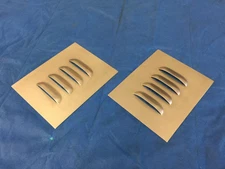RAC68
Darth Vader
Offline
Hi All,
UPDATE
A while back I installed a bilge blower within my Cold Air Duct to bring additional air into the foot well of the cabin. After my initial install of a variable speed control and downward footwell air diverter in front of the cabin vent, an April testing within cool weather seemed to prove the concept. However, testing later showed that the unit was NOT a Success as hot radiator air recirculation was also brought into the foot well when running very slow as in traffic or stopped.
To help eliminate hot radiator recirculation, I created closed ducting between duct and grill as well as radiator and grill to help eliminate hot air draw. Although this effort was more extensive then expected, it did not do resolve the total problem as much of the issue depended upon air flow through the engine compartment.
Not wanting to install hood louvers or fender vents, Dougie indicated some very positive results for improving engine compartment flow from adding (4) 3" sets louvers to each inner fender well. Additionally, I added an on/off polarity switch to the variable speed switch in order to push air out of the Cold Air Duct when going slow or stopped. Although this polarity switch is now manual, it would be nice if I could figure a way to have it automatically and safely switch as sook as the car slows to a stop. Any ideas would be appreciated.
By the way, these additions have improved cooling and at some point this summer hope to change back to my original 4-bladded fan to see how it functions.
Ray(64Baj8P1)
UPDATE
A while back I installed a bilge blower within my Cold Air Duct to bring additional air into the foot well of the cabin. After my initial install of a variable speed control and downward footwell air diverter in front of the cabin vent, an April testing within cool weather seemed to prove the concept. However, testing later showed that the unit was NOT a Success as hot radiator air recirculation was also brought into the foot well when running very slow as in traffic or stopped.
To help eliminate hot radiator recirculation, I created closed ducting between duct and grill as well as radiator and grill to help eliminate hot air draw. Although this effort was more extensive then expected, it did not do resolve the total problem as much of the issue depended upon air flow through the engine compartment.
Not wanting to install hood louvers or fender vents, Dougie indicated some very positive results for improving engine compartment flow from adding (4) 3" sets louvers to each inner fender well. Additionally, I added an on/off polarity switch to the variable speed switch in order to push air out of the Cold Air Duct when going slow or stopped. Although this polarity switch is now manual, it would be nice if I could figure a way to have it automatically and safely switch as sook as the car slows to a stop. Any ideas would be appreciated.
By the way, these additions have improved cooling and at some point this summer hope to change back to my original 4-bladded fan to see how it functions.
Ray(64Baj8P1)

 Hi Guest!
Hi Guest!

 smilie in place of the real @
smilie in place of the real @
 Pretty Please - add it to our Events forum(s) and add to the calendar! >>
Pretty Please - add it to our Events forum(s) and add to the calendar! >> 



